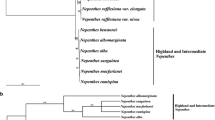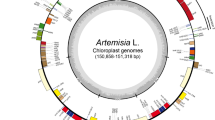Abstract
The taxonomic and phylogenetic relationships within the genus Artemisia s.l. (Asteraceae) are controversial, and it has been considered 1 to 8 different genera. This work re-investigated the phylogenetic relationships in Artemisia using nuclear ribosomal (ITS) and chloroplast psbA-trnH DNA sequences using three sections of Artemisia, Dracunculus, and Serphidium. Three phylogenetic trees were conducted separately on the basis of ITS, psbA-trnH and combined sequences using maximum parsimony. The results showed that the three sections were clearly separated from each other, and that the heterogamous Dracunculus and Artemisia are closely related to each other than either to homogamous Serphidium. This may suggest the taxonomic importance of capitulum morphology in Artemisia s.l. Our data also cast doubt on the use of cytogenetic similarity e.g., basic chromosome number in grouping Serphidium and Artemisia s.s. Furthermore, AMOVA analysis showed a higher level of ITS (55.29%) and combined ITS+cppsbA-trnH (55.63%) variations among sections. This provides further evidence for separation of these three sections and supports the phylogenetic results. The higher ITS nucleotide differences detected in Artemisia (30.4737) compared to very low value in Dracunculus (2.3333) and Serphidium (1.23077) may propose that the Artemisia comprises of several incipient sections. This supports the previous suggestion that Artemisia is a complex group.
Similar content being viewed by others
References
Bremer K.R. & Humphries C.J. 1993. Generic monograph of the Asteraceae-Anthemideae. Bull. Nat. Hist. Mus. Bot. Ser. 23: 71–177.
Cronquist A. 1955. Phylogeny and taxonomy of the Compositae. Amer. Midland Natural. 53: 478–511.
Excoffier L., Laval G. & Schneider S. 2005. Arlequin (version 3.0): an integrated software package for population genetics data analysis. Evol. Bioinform. Online 1: 47–50.
Excoffier L., Smouse P.E. & Quattro J.M. 1992. Analysis of molecular variance inferred from metric distances among DNA haplotypes: application to human mitochondrial DNA restriction data. Genetics 131: 479–491.
Felsenstein J. 1985. Confidence limits on phylogenies: an approach using the bootstrap. Evolution 39: 783–791.
Hall H.M. & Clements F.E. 1923. The phylogenetic method in taxonomy: the North American species of Artemisia, Chrysothamnus, and Atriplex. Carnegie Institute of Washington Publication No. 326.
Kawatani T. & Ohno T. 1964. Chromosome numbers in Artemisia. Bulletin of the National Institute of Hygienic Sciences 82: 183–193.
Kornkven A.B., Watson L.E. & Estes J.R. 1998. Phylogenetic analysis of Artemisia section Tridentatae (Asteraceae) based on sequences from the internal transcribed spacers (ITS) of nuclear ribosomal DNA. Amer. J. Bot. 85: 1787–1795.
Kornkven A.B., Watson L.E. & Estes J.R. 1999. Molecular phylogeny of Artemisia section Tridentatae (Asteraceae) based on chloroplast DNA restriction site variation. System. Bot. 24: 69–84.
Kress W.J., Wurdack K.J., Zimmer E.A., Weigt L.A. & Janzen D.H. 2005. Use of DNA barcodes to identify flowering plants. Proc. Natl. Acad. Sci. U.S.A. 102: 8369–8374.
Librado P. & Rozas J. 2009. DnaSP v5: a software for comprehensive analysis of DNA polymorphism data. Bioinform. 25: 1451–1452.
Ling Y. 1991. A review of the classification, distribution and application of Artemisia L. and Seriphidium (Bess.) Poljak. (Compositae) in China. Guihaia 11: 19–35.
Ling Y. 1994. The genera Artemisia L. and Seriphidium (Bess.) Poljak. in the world. Compositae Newsl. 25: 39–45.
Ling Y. 1995a. The new world Artemisia L. Advances in Compositae systematics. Kew: Royal Botanic Gardens, Kew, pp. 255–281.
Ling Y. 1995b. The New World Seriphidium (Besser) Fourr. Advances in Compositae systematics. Kew: Royal Botanic Gardens, Kew, pp. 283–291.
Martin J., Torrell M. & Valles J. 2001. Palynological features as a systematic marker in Artemisia L. and related genera (Asteraceae, Anthemideae). Plant Biol. 3: 372–378.
McArthur E.D. & Pope C.L. 1979. Karyotypes of four Artemisia species: A. carruthii, A. filifolia, A. frigida, and A. spinescens. West. North Amer. Natural. 39: 419–426.
Persson K. 1974. Biosystematic studies in the Artemisia maritime complex in Europe. Op. Bot. 35: 1–188.
Poljakov P. 1961. Materials and systematics, the genus Artemisia L. Trudy Inst. Bot. Alma-Ata 11: 134–177.
Posada D. & Crandall K. 1998. Modeltest: Testing the model of DNA substitution. Bioinformatics 14: 817–818.
Rydberg P. 1916. Artemisia and Artemisiastrum. North American Flora 34: 244–285.
Swofford D. 2002: PAUP 4.0 b10: Phylogenetic analysis using parsimony. Sinauer Associates, Sunderland, MA, USA.
Tamura K., Peterson D., Peterson N., Stecher G., Nei M. & Kumar S. 2011. MEGA5: molecular evolutionary genetics analysis using maximum likelihood, evolutionary distance, and maximum parsimony methods. Mol. Biol. Evol. 28: 2731–2739.
Torrell M., Cerbah M., Siljak-Yakovlev S. & Vallčs J. 2003. Molecular cytogenetics of the genus Artemisia (Asteraceae, Anthemideae): fluorochrome banding and fluorescence in situ hybridization. I. Subgenus Seriphidium and related taxa. Plant Syst. Evol. 239: 141–153.
Torrell M., Garcia-Jacas N., Susanna A. & Vallčs J. 1999. Phylogeny in Artemisia (Asteraceae, Anthemideae) inferred from nuclear ribosomal DNA (ITS) sequences. Taxon 48: 721–736.
Torrell M., Vallčs J., Garcia-Jacas N., Mozaffarian V. & Gabrieliane E. 2001. New or rare chromosome counts in the genus Artemisia L. (Asteraceae, Anthemideae) from Armenia and Iran. Bot. J. Linn. Soc. 135: 51–60.
Vallčs J. & Siljak-Yakovlev S. 1997. Cytogenetic studies in the genus Artemisia L.: fluorochrome banded karyotypes of five taxa, including the Iberian endemic species Artemisia barrelieri Besser. Can. J. Bot 75: 595–606.
Vallčs J. & McArthur E.D. 2001: Artemisia systematics and phylogeny: cytogenetic and molecular insights. USDA Forest Service Proceedings, pp. 67–74.
Watson L., Bates P., Evans T., Unwin M. & Estes J. 2002. Molecular phylogeny of subtribe Artemisiinae (Asteraceae), including Artemisia and its allied and segregate genera. BMC Evol. Biol. 2: 17.
White T.J., Bruns T., Lee S. & Taylor J. 1990. Amplification and direct sequencing of fungal ribosomal RNA genes for phylogenetics, pp. 315–322. In: Innis M., Gelfand D., Sninsky J. & White T., (eds), PCR Protocols: a Guide to Methods and Applications, Acad. Press, Orlando, Florida
Ziegenhagen B., Liepelt S., Kuhlenkamp V. & Fladung M. 2003. Molecular identification of individual oak and fir trees from maternal tissues of their fruits or seeds. Trees 17: 345–350.
Author information
Authors and Affiliations
Corresponding author
Rights and permissions
About this article
Cite this article
Haghighi, A.R., Belduz, A.O., Vahed, M.M. et al. Phylogenetic relationships among Artemisia species based on nuclear ITS and chloroplast psbA-trnH DNA markers. Biologia 69, 834–839 (2014). https://doi.org/10.2478/s11756-014-0379-3
Received:
Accepted:
Published:
Issue Date:
DOI: https://doi.org/10.2478/s11756-014-0379-3




